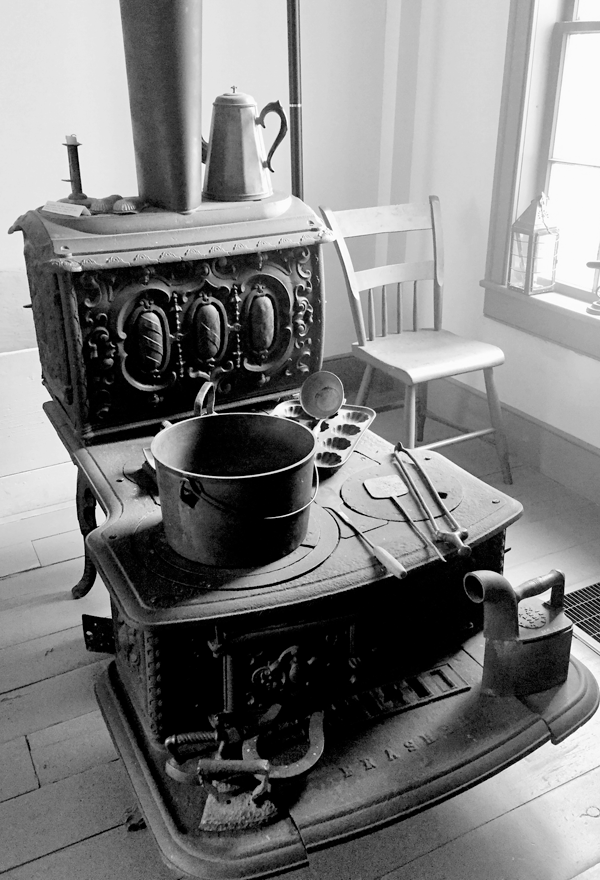- Hours and Admission
- What to See
- FAQ
Admission to the Silas Wright House & Museum:
- $5 for non-members
- Free for members and children 12 and under
| Regular Museum & Gift Shop Hours (March to December) | |
|---|---|
| Sunday & Monday | Closed |
| Tuesday – Saturday | 10:00 AM to 4:00 PM |
| Seasonal Closure Hours (January & February) | |
|---|---|
| Saturday & Sunday | Closed |
| Monday – Friday | 10:00 AM to 4:00 PM |
Please note that during our Seasonal Closure the museum is closed for tours. The Museum Gift Shop and Public Research Room are available by appointment. Please e-mail archives@slcha.org or call the office at (315) 386-8133 to schedule an appointment.
Parking
The Museum has free parking located behind the Silas Wright House and adjacent to the North Country Savings Bank, and can be access from Main Street or Court Street. Street parking is also available.
Silas Wright House Highlights

The Kitchen
The kitchen was one of the additions that the Wrights probably undertook in 1835. In a letter of that year, Silas Wright refers to men working on the house. The accurately furnished kitchen includes a wood stove, hand-carved wooden bowls and spoons, and a spinning wheel. At one time, a pantry existed to the right of the doorway leading into the dining room. The exterior door led to the garden and orchard. The floor boards are original. The cast iron cook stove is a St. Lawrence Stove manufactured at the Brasher Iron Works in the 1850s.
The Dining Room
The dining room was part of the original structure built in 1832-1833, and was used as the kitchen and living quarters until the addition of the new kitchen and the woodshed. Mrs. Wright would have used the fireplace and “beehive” oven during the couple’s first year in the house. The woodwork color is original, while the wallpaper suggests an oriental influence popular at this time. The original floorboards were replaced during the house’s restoration in the 1970s.
Dining Room Furnishings
The long Empire-style mahogany sideboard (left) was purchased by the Wrights in Albany in 1840. The butler’s desk is also believed to have belonged to the Wrights. Other notable furnishings include a Queen Anne-style lowboy, which dates to the late 1700s, and a set of six Empire-style tiger maple chairs (c. 1825).
The Study
The study seems to have been the heart of the house in the 1840s, as when at home, Silas spent much of his time here writing letters and conducting political business. The reproduction wallpaper is typical of the 1860s, when Wright’s widow Clarissa was still living in the house. The area to the left of the fireplace was originally a pantry.
Study Furnishings
The butternut and mahogany desk (c. 1825-1830), law books, and Assembly records belonged to Silas Wright. The room originally contained a bed – probably a day bed or cot. The sofa and Boston rocker also belonged to the Wrights.
The framed print of the Battle of Plattsburgh, 1814, recognizes Silas Wright, Sr.’s military service during the War of 1812. The print was donated to SLCCHC by descendants of the Wright family. Other furnishings in the study that are typical of the period include the case clock (c. 1814), the Sheraton chest of drawers (c. 1800-1820), and the Empire-style center table.
The Entrance Hallway
Notable in the hallway are the etched glass hall light, framed lithographs of George and Martha Washington, and a hand-painted floor cloth. The latter was not a household item of the Wrights, but floor cloths were commonly used in the homes of the period. Note also the attractive Greek Revival doorway.
The Entrance Hallway was restored in 1973 by Dr. Virginia Baker Haley in honor of Dr. Leon Frank Haley and Frank Leon Haley.
The Parlors
The spacious double parlors constituted the formal lifestyle expected of a Senator and Governor. In fact, the Wrights’ household inventory, completed in March 1848, lists some 54 side chairs. However, Silas Wright makes no reference in his letters to public entertaining.
Parlor Furnishings
The center table in the front parlor belonged to the Wrights, as did the pair of stenciled Hitchcock chairs (c. 1830) in the rear parlor. The pair of Sheraton card/game tables (c. 1800-1815) in the front parlor were brought into the county by the Hasbrouck family of Ogdensburg in 1825. On the walls of the front parlor hang two portraits – the larger one is of Silas Wright, Jr. and the smaller one opposite is of Ebenezer Miner, an early resident of Canton.
The piano (left) in the rear parlor was manufactured by the Badlam Piano Works of Ogdensburg around 1850. Also in the rear parlor sits a double column parlor stove (c. 1835) (above), and a rocking chair that belonged to the Knox family, some of the earliest settlers in Canton. The oil painting in the rear parlor, originally thought to be Clarissa Wright in her wedding bonnet, was purchased by SLCCHC at Sotheby’s auction in 1998. More recent research indicates that it is most likely a portrait of Susan Brown Moody, sister-in-law of Clarissa Moody Wright.
View our Silas Wright House & Museum Map to guide you on your tour.
More information coming soon. Thanks for your patience!
